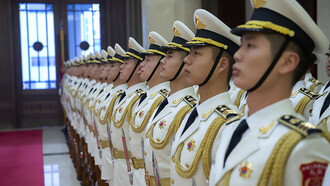A picture, so the saying goes, is worth a thousand words. This graphic reality was evident in last week’s picture of the APEC Summit in Peru, which saw the President of Peru smilingly flanking a confident President Xi Jinping in the front row, while the American President, a lame-duck Joe Biden, cut a shrunken figure, pushed to the corner in the second row. This visit of President Xi Jinping to South America conveyed two key messages.
The first message, albeit inadvertently, is that China has entered America’s ‘backyard’, South America, in a big way as part of the resurgence of the Global South, and the US seems relegated to the back burner in a region that it once virtually ‘owned’ since the two-century-old Monroe Doctrine, which now lies forgotten and irrelevant in the emerging realities of the 21st century’s new dynamics. It is perhaps no accident that while President Biden’s visit to Peru was his maiden tour of South America in his four-year tenure, this was President Xi Jinping’s fifth visit to the region. The symbolism of the retrenchment of US clout and power, even in its own ‘backyard’, was reinforced by the substance of China’s Belt and Road Initiative (BRI), probably the most significant diplomatic and development initiative of the 21st century, which has connected the Global South through the Maritime Silk Road.
President Xi Jinping inaugurated the Peruvian port of Chancay, funded and built at a cost of $3.5 billion, which will halve the shipping time from South America to Asia from 45 days to 23 days, boosting trade and commerce between the two continents. The second message, conveyed through President Xi’s frank remarks in his farewell meeting with President Biden at Lima, was even more important. China is ready for President Trump and is keen on a cooperative relationship, but China will defend what President Xi conveyed to President Biden as the ‘red lines’ for China in its relationship with the United States.
Speaking of China’s interaction with the US, Xi warned Biden of the yawning chasm between American professions and practices: ‘words must be trustworthy, and a person cannot stand without credibility. China always follows through on its words, but if the U.S. side always says one thing and does another, it is very detrimental to America’s image (as) it damages mutual trust). And then, for the first time that any Chinese leader has formulated, Xi put together China’s ‘four redlines’ before any American president, meaning these are non-negotiable:
Taiwan issue (Taiwan is an integral part of China and none can question or undermine the ‘One-China Policy’).
Democracy and human rights (US trying to ‘weaponize’ human rights in the context of Xinjiang, Tibet, and Hong Kong is unacceptable).
China’s path and system (the paramount role of the Communist Party of China as the pivot of the Chinese political system).
China’s development rights (no impediment to BRI and growth of the Chinese economy and technology).
Given this context, notwithstanding his hawkish anti-China team in foreign policy and national security, President Trump’s biggest challenge will be ‘Understanding China’ in the 21st Century: the world’s second-largest economy about to overtake the U.S. by 2030, China ‘the Scientific Superpower’ as The Economist cover story aptly put recently, plus China spearheading globalization (fueling 30% of global economic growth) and leading ‘Green Development’ in a world altered by the ravages of climate change, as China now leads in the production of electric vehicles, solar panels, and lithium batteries. Moreover, out of 193 members of the United Nations, 130 countries today have more trade with China than they have with the United States.
So, with the West in decline, the Ukraine Conflict seeing an end bereft of any Russian defeat, and the US-led ‘rules-based international order’ in tatters in the aftermath of the Gaza Genocide, which has exposed Western immorality, hypocrisy, and double standards, China and Russia have jointly laid the building blocks of an alternate emerging global order, based on regionalism (BRI, BRICS, and SCO), and connectivity via energy, economy, ports, pipelines, roads, and railways. The Global South, the world’s majority, is now a reality, and the views of the Global South are already at variance with Western views on Palestine, the Ukraine war, BRI, and free trade and protectionism.
Basically, the US has missed the bus on trying to ‘contain’ China or conjure up a ‘new cold war’ through a security-centric mindset; it’s too late now and it cannot happen in a changing international milieu where the global center of gravity is shifting from the West to the East. During the post-9/11 period, thanks to imperial hubris, the US squandered $6.5 trillion in the ‘War on Terror,’ which ended in an unmitigated disaster. No wonder Trump is seeking court martial of the generals who presided over the humiliating American exit from Afghanistan! Conversely, in the same period, China, through its economic statecraft, invested $1 trillion in 3000 projects from Pakistan to Peru (Gwadar port and Chancay port).
In this changing world, the choice before the Trump Administration is clear: pursue a tried, tested, and failed policy towards China, or adjust to new realities and seek a modus vivendi based on mutually beneficial interests between China and the United States. Perhaps they can take a leaf out of The New York Times story on November 14 about the failure of American technology sanctions against China’s Huawei: ‘Huawei is roaring back in business,’ opening up profitable ventures and still dominating the Hi-Tech Telecom market. It would be great for Chinese-American relations as well as global peace and stability if the incoming Trump Administration learned the right lessons from these new global realities rather than engaging in an exercise in futility for ‘containment’ of an unstoppable China on the rise.















